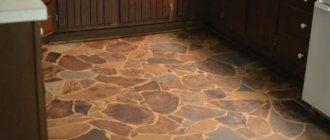Malka: an indispensable assistant in construction
When performing construction or carpentry work, there is often a need to measure angles. For such purposes, a tool called a malka was invented. In the construction industry, this device allows you to speed up and facilitate the execution of work, ultimately achieving excellent results. We will learn in more detail how to use the small tool correctly, as well as the features of measuring angles.
Malka protractor. The Builder's Essential Protractor
Finishing slopes always causes some difficulties even for experienced craftsmen, not to mention amateurs who have undertaken to do home repairs on their own. It is quite possible to achieve perfectly smooth slopes with the same angles if you know some professional tricks. In order to determine angles other than 90 degrees, a special device is used called a goniometer . It will significantly speed up and facilitate your work, helping you achieve excellent results without extra effort. Using it, you may not have to think about how to measure the angle and how to transfer it to the workpiece.
Protractor protractor
This is one of the popular DIY tool methods that can be found online. Even a child can do it. A minimum of materials will be required.
Necessary materials
For manufacturing you will need the following materials:
- Stationery protractor (in the shape of a semicircle, preferably made of transparent plastic);
- Laser pointer;
- Strong thread (can be replaced with thick fishing line);
- Fishing sinker with an eye (you can use a nut);
- Superglue and baking soda;
- Matches or lighter, needle.
The cost of such a protractor is literally 50 rubles. And this is taking into account the cost of the laser pointer and batteries required for operation.
Important! Matches and a needle are needed to make a small hole in the protractor. This can be done more accurately using a Dremel type grinder and a thin drill.
Manufacturing instructions
So, a protractor is made according to the following scheme:
- A small hole is made exactly in the center at the bottom of the protractor. The point will be on a line drawn perpendicular to the base from a mark of 90°. The hole can either be drilled or made using a hot needle. The latter is only needed for plastic devices - this is what it is advisable to use.
- A fishing sinker is tied to the thread. She will be like a pendulum. The recommended weight of the weight is 5 grams or more.
- The thread is threaded through the hole in the protractor. A knot is made at the threaded end so that the resulting thickening allows the thread not to slip out of the hole. You can fix the pendulum using superglue, but you don’t have to wait until it hardens - just add a pinch of baking soda and this mixture will instantly harden.
- A laser pointer is attached to the bottom edge of the protractor. You can also fix it with superglue and baking soda. If there are any irregularities on the pointer body, it is better to remove them or completely rub them with a file.
If possible, you should check the accuracy of the protractor using a building level (you need one that has a spirit level).
Usage
If everything is done strictly according to the instructions, then such a homemade protractor will have a maximum error of only 1-2 degrees, no more. To measure the angle you will need:
- Stand on a flat surface;
- Raise the structure to chest level, turn on the laser pointer;
- Point the laser point at the plane from which the angle is measured (preferably it should be a flat plane perpendicular to the ground);
- Fix the position of the protractor and thread;
- Look at the mark on the protractor that the pendulum thread points to.
Please note that you will need to subtract 90° from the indicated mark on the protractor. Naturally, such a homemade product will not replace a full-fledged building level, but in critical cases it will be enough to take measurements.
How to use malka - step by step diagram
Step 1: Preparing the walls and window opening
All walls of the room in which you plan to make slopes must be completely plastered. As a rule, the plaster ends at window openings. The slopes themselves must be prepared, cleaned of dust and treated with soil. Also, if the window was installed using polyurethane foam, the protruding excess must first be removed with a knife.
Step 2: Select the “dawn angle”
Now we need, first of all, to decide on the angle at which the plastering will be carried out on the slopes. To do this, we install the block along the edge of the window frame and, by moving the pen, determine the angle along the edge of the window opening from the wall side. We record the result obtained on the small scale and check the compliance along the perimeter of the window opening. If, when checking, the selected angle does not coincide with the selected value, it is necessary to cut the plaster from the side of the wall or change the angle on the grinder.
Step 3: Leveling the slope angle
Usually, on a window opening, the plaster ends up in a chaotic manner; even corners are created when working with slopes. In order to make ideal slope angles, you just need to install the rail on the wall along the edge of the slopes around the perimeter of the window. To do this, we use a small tool to determine where the edge of the slats will be located, and fasten it with self-tapping screws or ordinary nails to the wall. Don’t forget to check the rail vertically with a building level; it must be strictly level.
Step 4: Apply the solution, set the angle
When the slats are installed on the corners of the slopes, we begin to apply the plaster mixture. To do this, apply the solution to the slope with a trowel at an angle, preferably with a slight excess. After sanding, remove excess plaster mixture and set the slope to the direction of the angle. In this case, install the block on the window frame, exactly as we did during measurements, and slide the block along the frame from bottom to top. At the same time, the pen will remove excess and level the working surface. If after the work done there are holes on the slope, add mortar and again remove the excess with chalk.
Step 5: Finishing
Typically, when constructing slopes, the layer of plaster can reach 5 mm or more. In this case, do not rush to immediately level the slope to zero; due to its heaviness, the solution may simply fall off or “float”. In this case, it is better for him to stand for 24 hours. The next day, when the solution has hardened, you need to use a plaster float to fill in all the imperfections in the form of depressions with the mixture and grind the surface to zero.
Thanks to this method, your slopes will be quite smooth and aesthetically pleasing, plus, this method does not provide for the additional installation of beacons. By applying this approach in practice, you will be able to make slopes throughout the house with the same “dawn angle”.
Source: remoskop.ru
How to make malka yourself
Malka is such a simple tool that you can make it from scrap materials with your own hands. To make malka at home from materials you will need the following parts:
- A block of quality wood. The block can be divided into two parts or a groove of 2 mm in size can be made in it to the middle of the piece of wood. By the way, the size of the wood may be different, but it is better to make it up to 30 cm. The first part of the tool is a fixed block
- As a moving part, it is better to take an old ruler in which a groove should be made. The length of this groove should be equal to half the size of the ruler itself. Instead of a ruler, you can use a thin board up to 2-3 mm
- To connect these two parts you will need to use a bolt and a thumb. Pre-drilled hole in the block
How to use a small tool using the example of constructing slopes
Let's now test the little thing you made in working conditions, and it will be tested on the installation of window slopes. Our tool will help you carry out proper plastering based on existing standards. As you know, window slopes have a certain angle; builders call it the “dawn angle.” But according to the rules, all angles must be the same and symmetrical; if these rules are not followed, then different slopes will be visible to the naked eye. Here are instructions on how to use a grinder to get uniform angles.
Creating a Swenson Square
The author of such a useful device did not have time to properly file a patent for his brainchild, and numerous businessmen are actively using this.
The only thing they can't use is the special diamond cut hole, but some very resourceful competitors make a slightly different shaped slot. In the initial version, the Svenson square did not have a comb for special parallel markings and the hole itself. However, the comb is not an option that you cannot do without. It must be said that in almost a hundred years of history the device has not undergone significant changes.
Application
As already noted, goniometer devices have found their application in almost all sectors, industry, and transport.
In the construction industry, goniometers are used when performing installation work, marking and design work. With its help, they control the installation of building structures that are located at a certain angle relative to each other. Moreover, measurements can be carried out in three planes. In addition to the goniometer, plumb lines and levels are used in construction.
In addition, goniometric tools are used in carpentry, carpentry, and geodesy. Even in medicine, this instrument is used to control joints, spine, etc.
To take measurements
In order for the floor covering to be smooth and last a long time, you will need a tool to take measurements and markings. The master needs to have on hand:
- Roulette. This useful household device will be required often when laying laminate flooring. Even before work begins, you will need to take measurements of the rooms in order to know how much material you will need to buy.
- Meter ruler made of metal. If a tape measure is convenient for taking measurements of large-scale objects, then for measuring small parts and drawing straight lines you cannot do without a ruler.
- Metal square. Necessary for laying right angles.
- Protractor. This measuring tool is needed if you plan to lay the laminate flooring diagonally or shaped. In this case, it will be possible to cut the lamellas not only at a right angle, but also at an acute angle.
Advice! Instead of a protractor, you can use a device for a similar purpose - a protractor.
- Pencil. The purpose of this device does not need to be explained to anyone; it is necessary for applying marks.
The main tasks of this tool
The main purpose of the grinder is to measure the existing angle and then transfer it to the workpiece or a more accurate measuring device. They are extremely popular when installing window sills. Using this tool, the angle of repose is measured, after which it is transferred directly to the workpiece, which allows you to cut the required size as accurately as possible.
The adjustable bevel is also used to determine the “dawn angle” during the installation of window slopes. Initially, the device was used in carpentry workshops, but over time it gained wide popularity in construction. Not every builder knows why the tool in question is needed, and some are even hearing about it for the first time. This is not surprising, since this tool is used exclusively when it is necessary to measure degrees of an indirect angle. Malka allows you to measure angles from 0 to 180 degrees. This tool is an ordinary bench square, which has a right angle. To measure angles using the tool in question, the device has a moving part, which determines the required size.
Malki are also called protractors, which today come in various types, shapes and sizes. Protractor meters with a size of 300 mm are popular, which allows you to measure different lengths of angles. Protractors are also made of wood, plastic or metal. You can measure angles using a protractor, but this is very inconvenient and time consuming. Recently, an electronic protractor has appeared that allows you to measure angle accuracy up to 1 mm.
Malka is a goniometer that can do a lot
Let's immediately look at the tasks for which this measuring device is intended. As a rule, the main purpose of such a device is to measure the degrees of an existing angle and subsequently transfer it to a workpiece or a precision measuring device. It is especially convenient and useful when installing window sills: having measured the exact angle of the slope, you can easily transfer the markings to the workpiece and quite accurately cut the corners, and carry out further installation.
Also used to calculate the “dawn angle” when installing window slopes. Initially, the device was used for working with wood, but later migrated to other areas of construction work. Visually, this tool is very similar to a regular bench square with a right angle. But by its specificity, the malka is a protractor, and in order to be able to measure angles, the instrument has a moving part, which directly determines the given angle, both acute and unfolded.
- The block is the basis of the entire tool. On a regular square, this is its lower part; on both tools, the block performs the same role. Only on the small block the block has a slot into which the other part of the tool is hidden.
- The pen is the moving part of the instrument. The groove in the block allows the tool to be folded, so it takes up very little space and is convenient for the master to use.
- The fastening element is usually made in the form of a wing nut. Allows you to fix the moving part and make precise dimensions.
It is worth noting that this measuring device can be made in either a wooden or metal version. A wooden clapper is usually used where there is a fear of damaging the surface; the wood does not leave scratches during measurements.
Instructions for using the goniometer grinder
Often, when a simple tool falls into the hands of a specialist, the question arises of how to use it correctly. One of these tools is a grinder, which is better known as a protractor or surface planer. The material describes the process of measuring slopes using the instrument in question. But what else can you use such a simple and uncomplicated tool for, which you can make easily and quickly with your own hands.
What a malka is and why a protractor is needed is explained in detail in the material. It remains to understand the potential of the tool and find out what actions this device is capable of. Without exaggeration, the possibilities of the tool can be called limitless, since with the help of the device you can measure any angle and find out its exact values. This can be not only a window slope, but also an arch or greenhouse structure, the manufacture of which is carried out by a specialist.
If you don’t know how to use a protractor correctly, then it’s time to look into this issue in detail. To learn how to work with a small spoon, you need to follow an example. So, recently the issue of insulating the walls of a house with polystyrene foam or expanded polystyrene has become relevant. Why might you need a protractor when working with polystyrene foam? Everything is banally simple. If you need to stick foam plastic on the wall of a house that has a triangular or uneven shape, then in this case you will need to use a small tool. This is not necessary, but it will greatly simplify the work.
- To avoid having to measure the angle of inclination of the wall, you need to take a small piece of wood and apply it with one part to a straight angle, and the other to an indirect one.
- After this, you need to fix the moving part in the installed position by screwing the thumb in the central part of the tool
- Attach the protractor in a fixed form to the foam sheet and make a mark with a pencil or marker
- The radius of the corner is known, so all that remains is to use a rule or level to apply it to the resulting mark and draw it to the edge of the foam sheet
- Pick up a cutting tool for cutting foam plastic, which can be not only a construction knife, but also a metal blade. Few people know, but you can also cut polystyrene foam or polystyrene foam with the attachment of a hair dryer. How to cut a sheet of foam plastic if its thickness is greater than the length of the blade of a construction knife. To do this, you can take a special attachment on a hair dryer and make a cut along the mark
- Now the foam plastic in which the corner is cut can be applied to the wall and make sure that the procedure is performed correctly and with maximum accuracy
This is an example of the use of a screed, but the construction sector is not limited to the use of a screed. The device is also used in furniture making, when an irregularly shaped tabletop is made to order.
Often such a tool must be used when carrying out welding work, for example, when it is necessary to make metal posts for an arch or greenhouse with the same deflection angle. Whenever there is a need to cut an angle of the corresponding degree, you will need to pick up a protractor.
It is always convenient to work with this simple and uncomplicated device. Moreover, you don’t need to buy it, because it’s easy to make it yourself. If you set out to buy a small one, then you don’t need to go to hardware stores for this. For this, there are online stores where you can choose a suitable tool of good quality and at a low price. If you don’t yet know how to use a malka, then it’s time to learn, especially since it’s easy and simple.
As a result, it is important to emphasize such a factor as the effectiveness of the goniometer. Without such a tool, making an accurate measurement of an indirect angle would be very difficult. This would require a protractor, which would calculate the angle and then transfer it to the projected plane or workpiece. The video provides a detailed report on making malka with your own hands.
We make slopes without problems
Most often, a goniometer is used when constructing window and door slopes. Using this tool, you can achieve not only even corners, but also properly plaster the surface.
It is important that the corners have the correct angle of dawn and are symmetrical relative to each other. It is almost impossible to achieve this by eye: the difference between the slopes is immediately noticeable.
How to get even slope angles? First of all, you need to prepare the walls for work. To do this, they are plastered, removing all visible irregularities. Areas of future slopes are cleaned of dirt and dust and primed. If there are traces of polyurethane foam on the window, its protruding parts are cut off.
Then you need to choose the right sunrise angle. To do this, you need to decide at what angle the plaster will be applied. This can be done using a goniometer. Its block must be placed on the edge of the window frame. The angle is determined using a pen; this is done from the side of the walls. After this, the result is recorded, and the remaining angles are checked with a small tool. If there is a discrepancy, another indicator is selected on the device, or excess plaster is knocked out.
In order for the slopes to become identical, their angles need to be aligned. Plasterers usually don't level the plaster near windows and it looks ragged. Before starting work, it is necessary to align these corners. To do this, you can install a leveled rail on the wall. Then the desired angle is set and the solution is applied at this angle.
Before plaster is applied to the slopes, it is necessary to secure the slats to the walls. This can be done using nails or self-tapping screws, depending on what material the walls are made of. After the slats are removed, the holes formed by the fastenings can be filled with putty.
The mixture must be applied in excess to the slope. To ensure that the plaster does not fall off and lies flat, it is applied at an angle; you need to act from the center to the corner. A goniometer will be needed to remove excess plaster from the slopes. Using the same tool, the corner is given the desired direction: to do this, the block must be moved to the window frame. You need to run the block along the frame, directing it from top to bottom. Using a pen, the goniometer leveles the surface and removes excess plaster from it. Sometimes pits appear during the work process. Getting rid of them is not difficult: just put more mixture on the recess. Excess amount can also be removed with malt.
The final stage of slope removal is finishing. For slopes, the normal thickness of the plaster layer is 5 mm. If an inexperienced master worked, the layer may be much thicker. In this situation, you usually want to immediately level the slope, but there is no need to rush into this, since the plaster solution has a large mass and falls off if handled carelessly . In order to avoid having to do all the work again and correct mistakes, it is better to give the plaster the opportunity to set a little in the form that it already exists.
You should wait about a day. After the plaster has set, you will need to use a special grater to clean it. This tool will allow you to remove all the crumbs and depressions that appeared on the slopes while working with them. If desired, the surface can be made perfectly flat, but you need to work with caution: some craftsmen remove too much layer of plaster and make deep depressions that have to be repaired.
The manual sanding method is quite dusty, so it is better to use a protective bandage. Using this method, the master will not have to resort to using additional tools or materials, and the angles of dawn will be the same.
Source: proinstrumentinfo.ru











